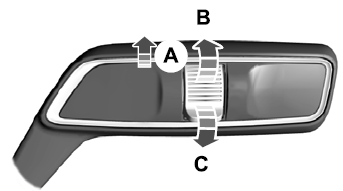Lincoln Corsair: Seatbelt Systems / Diagnosis and Testing - Seatbelt Systems
Symptom Chart(s)
Preliminary Inspection
Diagnostics in this manual assume a certain skill level and knowledge of Ford-specific diagnostic practices.
REFER to: Diagnostic Methods (100-00 General Information, Description and Operation).
Before diagnosing or repairing the seatbelt system, inspect the following items:
- Seatbelt webbing integrity (torn, frayed, cut or stretched)
-
Seatbelt buckle and tongue assembly (latching and release, foreign debris)
REFER to: Seatbelt System Functional Tests (501-20A Seatbelt Systems, General Procedures).
Symptom Chart: Seatbelt System
Symptom Chart
| Condition | Action |
|---|---|
| The seatbelt warning indicator does not operate | GO to Pinpoint Test A |
| The seatbelt warning chime does not operate | GO to Pinpoint Test B |
| The seatbelt retractor webbing does not extract or exhibits excessive pressure on the occupant during use | GO to Pinpoint Test C |
| The seatbelt retractor webbing does not retract or has excessive slack during use | GO to Pinpoint Test C |
| The Belt-Minder® feature is inoperative | GO to Pinpoint Test D |
| The seatbelt tongue is rotated on the seatbelt webbing | GO to Pinpoint Test E |
| The seatbelt webbing is twisted at the seatbelt guide | GO to Pinpoint Test E |
| The seatbelt webbing is dirty or soiled | GO to Pinpoint Test E |
Pinpoint Tests
.jpg) PINPOINT TEST A: THE SEATBELT WARNING INDICATOR DOES NOT OPERATE
PINPOINT TEST A: THE SEATBELT WARNING INDICATOR DOES NOT OPERATE|
Normal Operation and Fault Conditions Turn the ignition on and monitor the airbag warning indicator after the IPC proves out.
Possible Sources
|
| Diagnostic steps are not provided for this symptom or DTC. REFER to: Diagnostic Methods (100-00 General Information, Description and Operation). |
.jpg) PINPOINT TEST B: THE SEATBELT WARNING CHIME DOES NOT OPERATE
PINPOINT TEST B: THE SEATBELT WARNING CHIME DOES NOT OPERATE|
Normal Operation and Fault Conditions Turn the ignition on and monitor the airbag warning indicator after the IPC proves out.
Possible Sources
|
| Diagnostic steps are not provided for this symptom or DTC. REFER to: Diagnostic Methods (100-00 General Information, Description and Operation). |
.jpg) PINPOINT TEST C: SEATBELT RETRACTOR CONCERNS
PINPOINT TEST C: SEATBELT RETRACTOR CONCERNS|
Normal Operation and Fault Conditions The seatbelt retractor webbing does not extract or exhibits excessive pressure on the occupant during use
The seatbelt retractor webbing does not extract or exhibits excessive pressure on the occupant during use The seatbelt retractor webbing does not retract or has excessive slack during use
The seatbelt retractor webbing does not retract or has excessive slack during use Possible Sources
|
| Diagnostic steps are not provided for this symptom or DTC. REFER to: Diagnostic Methods (100-00 General Information, Description and Operation). |
.jpg) PINPOINT TEST D: BELT-MINDER® CONCERNS
PINPOINT TEST D: BELT-MINDER® CONCERNS|
Normal Operation and Fault Conditions Using the diagnostic scan tool, verify the Belt-Minder® feature is activated.
Possible Sources
|
| Diagnostic steps are not provided for this symptom or DTC. REFER to: Diagnostic Methods (100-00 General Information, Description and Operation). |
.jpg) PINPOINT TEST E: SEATBELT WEBBING CONCERNS
PINPOINT TEST E: SEATBELT WEBBING CONCERNS|
Normal Operation and Fault Conditions The seatbelt tongue is rotated on the seatbelt webbing
The seatbelt tongue is rotated on the seatbelt webbing The seatbelt webbing is twisted at the seatbelt guide
The seatbelt webbing is twisted at the seatbelt guide The seatbelt webbing is dirty or soiled
The seatbelt webbing is dirty or soiled Possible Sources
|
| Diagnostic steps are not provided for this symptom or DTC. REFER to: Diagnostic Methods (100-00 General Information, Description and Operation). |
 Description and Operation - Seatbelt Systems - System Operation and Component Description
Description and Operation - Seatbelt Systems - System Operation and Component Description
System Operation
Emergency Locking Retractor (ELR)
All
retractors have an Emergency Locking Retractor (ELR) mode, which is a
vehicle-sensitive feature designed to activate and lock the seatbelt
webbing during hard braking, cornering, or an impact of approximately 24
km/h (15 mph)...
 General Procedures - Locked Seatbelt Retractor Releasing
General Procedures - Locked Seatbelt Retractor Releasing
Repair
NOTE:
If the seatbelt webbing does not extract from the seatbelt
retractor from the stowed position, this may be due to a normal
condition which happens when the seatbelt retracts at a high rate of
speed...
Other information:
Lincoln Corsair 2020-2026 Service Manual: General Procedures - Adaptive Learning Drive Cycle
Configuration NOTE: The engine and transmission must be at normal operating temperature. Using the scan tool, clear the DTC and Transmission Adaptive Tables. Bring the transmission to normal operating temperature. Follow the table below to complete the Adaptive Learning Drive Cycle...
Lincoln Corsair 2020-2026 Service Manual: Removal and Installation - Rear Wheel Speed Sensor - LHD 4WD
Materials Name Specification Motorcraft® Metal Brake Parts CleanerPM-4-A, PM-4-B, APM-4-C - Removal NOTE: Removal steps in this procedure may contain installation details. Remove the wheel and tire. Refer to: Wheel and Tire (204-04A Wheels and Tires, Removal and Installation)...
Categories
- Manuals Home
- 1st Generation Lincoln Corsair Owners Manual
- 1st Generation Lincoln Corsair Service Manual
- Child Safety Locks
- Automatic Transmission - 8-Speed Automatic Transmission – 8F35/8F40
- Interior Lamps
- New on site
- Most important about car
Autowipers (IF EQUIPPED)
Wet or winter driving conditions with ice, snow or salty road mist can cause inconsistent and unexpected wiping or smearing.


.jpg) PINPOINT TEST A: THE SEATBELT WARNING INDICATOR DOES NOT OPERATE
PINPOINT TEST A: THE SEATBELT WARNING INDICATOR DOES NOT OPERATE